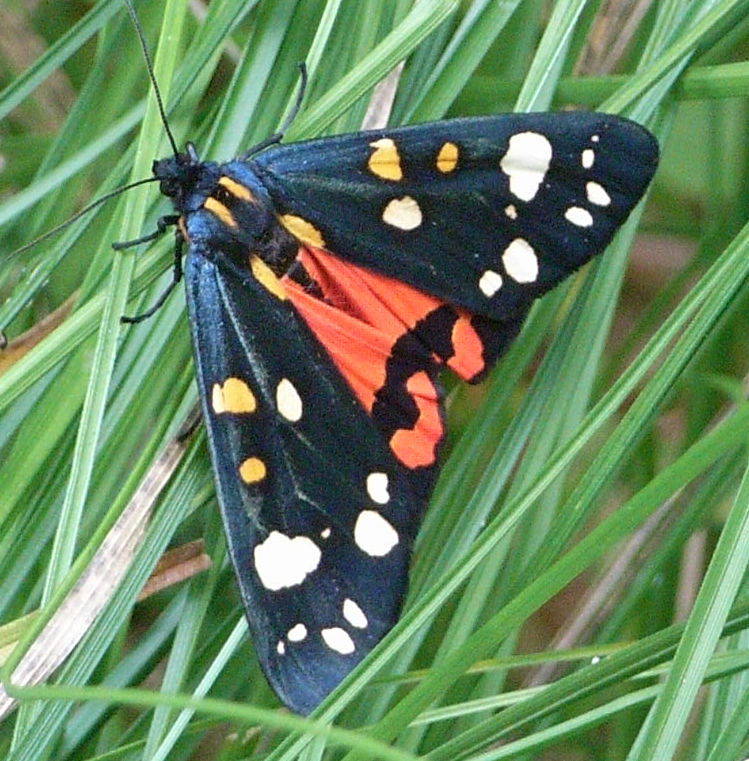- Home
- Garden Wildlife
- Insects
- Lepidoptera
- Day flying moths
Day-flying moths
The great majority of our moths fly in the night. If you have a moth trap you can capture them easily, but otherwise you are unlikely to see them except as caterpillars. There are however quite a number of species which are semi-active in the daytime, especially if disturbed, and a few which always fly in the daytime.
The definitive account of our day- flying moths is the new edition of the book by David Newland, Robert Still and Andy Swash listed below. 41 species listed in this book were recorded by Jennifer Owen in her garden - to which we can add a couple of others which may be seen occasionally. Moth families are illustrated in our introduction page.
Clearwing moths family Sesiidae
There are about 15 British and Irish species in this fascinating family, which specialises in rapid day-time flight, and mimicry of hornets, wasps and bees. They are not easy to find, but the males can be attracted to specific pheromone lures. We cover and illustrate these moths in our page on stem-boring moths.
Geometrid moths
There are about 60 day-flying geometrid moths in Britain and Ireland. Jennifer Owen recorded 8, of which the
garden carpet Xanthorhoea fluctuata, the silver-ground carpet Xanthorhoea montanata and the common carpet Epirrhoe alternata were common. The blood-vein Timandra comae is an attractive garden species.
Other sources of information
Websites
Mothscount leaflet on day-flying moths
Books
Newland D.E, Still R. and Swash A. (2019) Britain’s Day-flying Moths: A Field Guide to the Day-flying Moths of Britain and Ireland. Princeton University Press
Field Studies Council (2006) ID Chart - Guide to the Day-flying Moths of Britain
Page drafted and edited by Steve Head
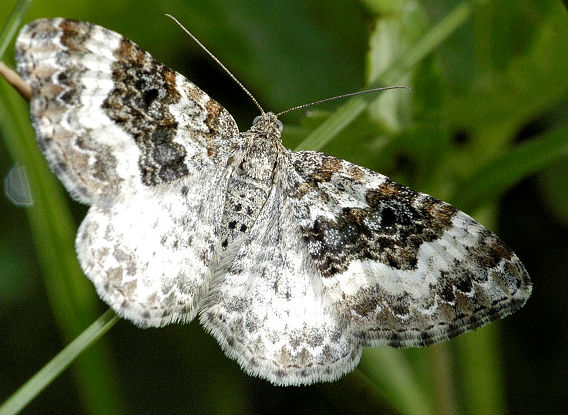
![Silver-Ground Carpet Xanthorhoe montanata Photo: by Ben Sale from UK - [1727] , CC BY 2.0, https://commons.wikimedia.org/w/index.php?curid=63701914](images/1280px-(1727)_Silver-Ground_Carpet_(Xanthorhoe_montanata)_(3119036200).jpg)
.jpg)
From left: silver-ground carpet Xanthorhoea montanata, common carpet Epirrhoe alternata, blood-vein Timandra comae
Humming-bird hawkmoth Macroglossum stellatarum Jennifer Owen considered this summer migrant moth scarce, but it appears increasingly often some years across most of (especially coastal) Britain and Ireland. They are very fast flyers, able to hover like a humming-bird to sip nectar with their long proboscis, and they make a clear humming noise in flight. They are known to breed here in good summers (larvae feeding on lady's bedstraw Galium verum) and some have over-wintered as adults. With climate change, this moth may become a resident species.
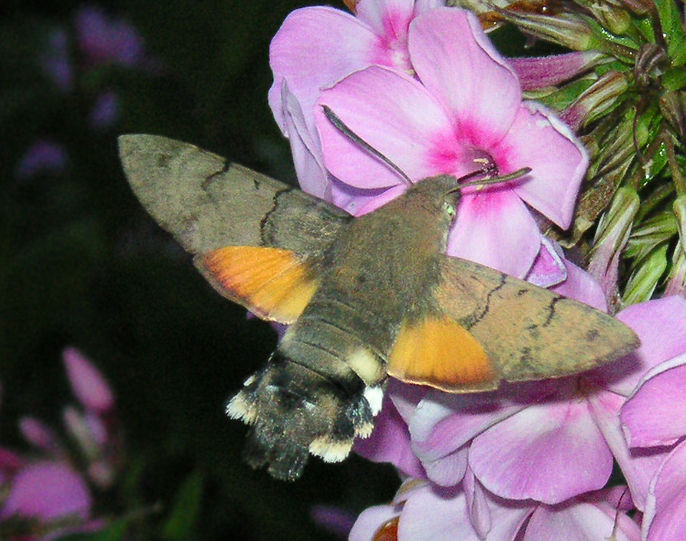
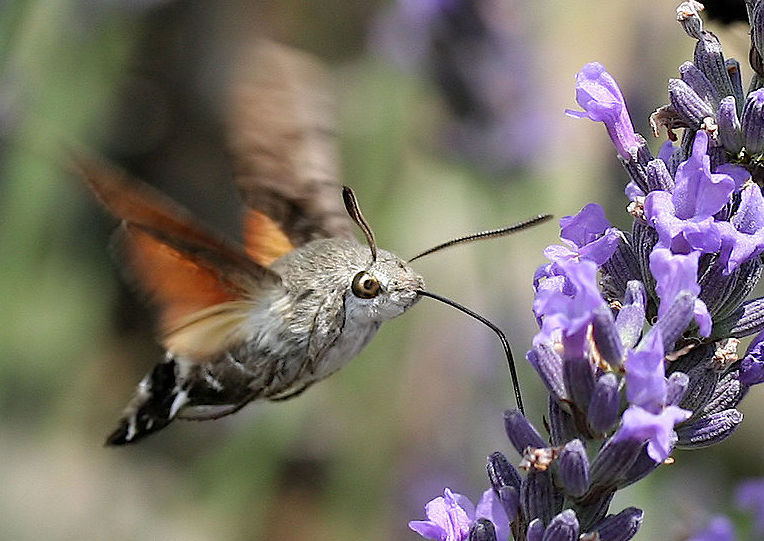
Humming-bird hawk moth
There are two other day flying hawkmoths in Britain, the bee hawks, but they are scarce and not found in gardens.
Erebid moths
The vapourer Orgyia antiqua and the muslin moth Diaphora mendica are day-flying erebids recorded by Jennifer Owen, but two other species seen in gardens are much more spectacular. The scarlet tiger moth Callimorpha dominula is found in gardens in western southern England and Wales and is as strongly day-flying as a butterfly. The cinnabar moth Tyria jacobaeae is a weaker flyer, but equally conspicuous. Its larvae feed on ragwort Senecio jacobaea. The ruby tiger Phragmatobia fuliginosa often flies in its spring brood, but is less likely to in the late summer generation.
.jpg)
Above Left: scarlet tiger moth Callimorpha dominula Right: cinnabar moth Tyria jacobaeae.
Below Left: muslin moth Diaphora mendica female and Centre: male. Right ruby tiger Phragmatobia fuliginosa
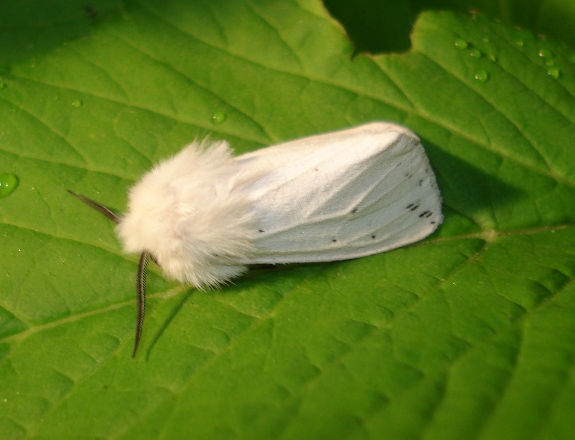
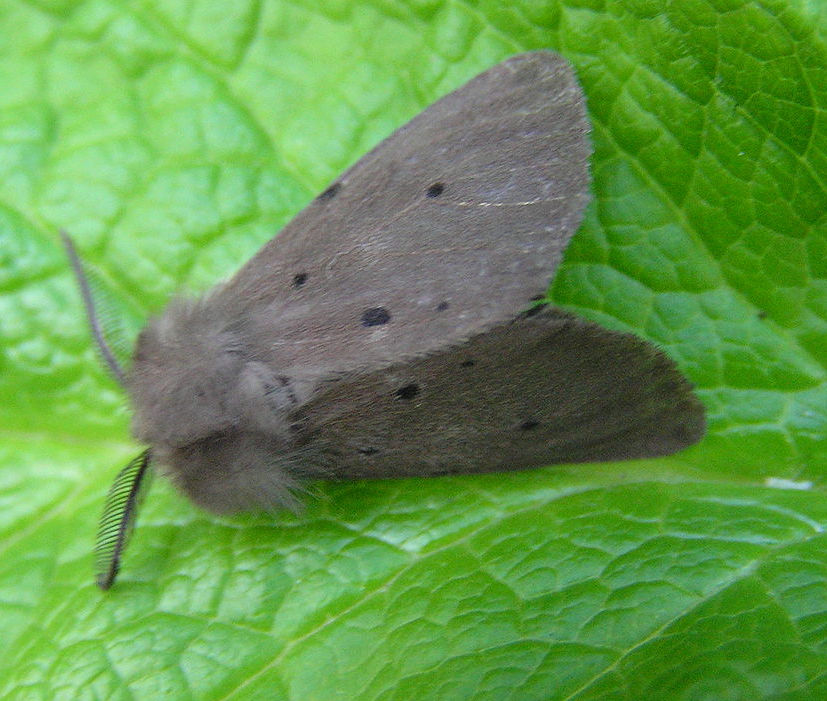
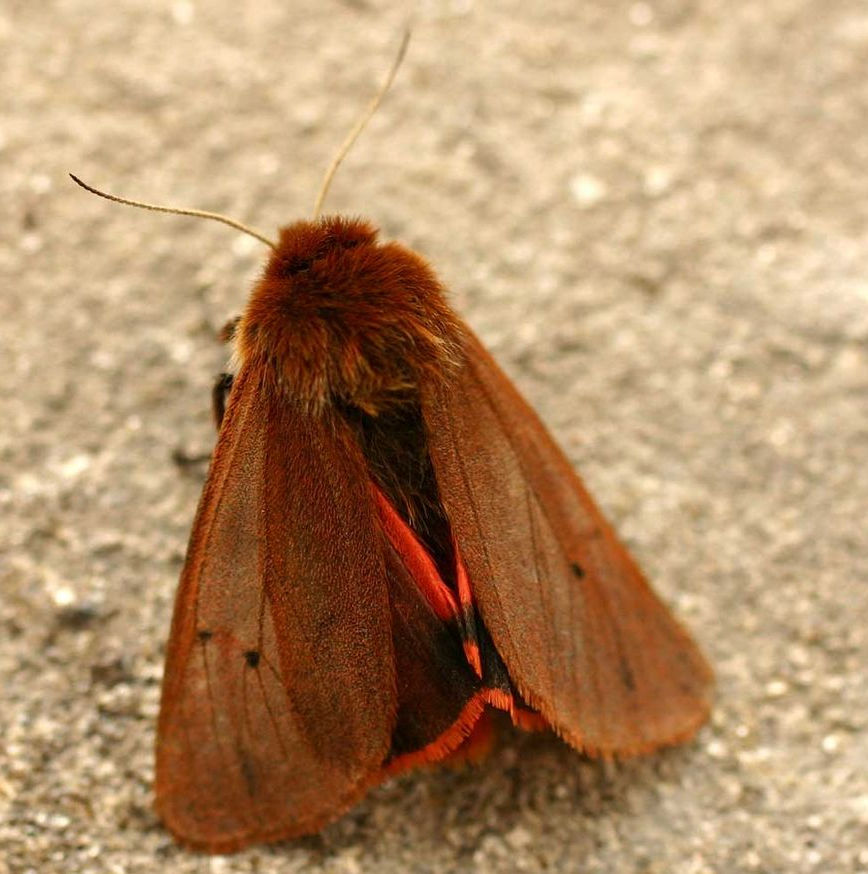
Noctuid moths
Most of these are night-flyers, but one species, the silver Y Autographa gamma is very common and often seen in the daytime, either as you disturb individuals as you walk through vegetation, or flitting from flower to flower. It is mainly a regular immigrant from the continent, arriving in early spring and then managing several generations before winter, which generally they do not survive. Another, in this case resident moth is the large yellow underwing Noctua pronuba. This is commonly disturbed from vegetation in mid summer, and flies away fast to hide, showing the bright yellow flash of the hind wing.
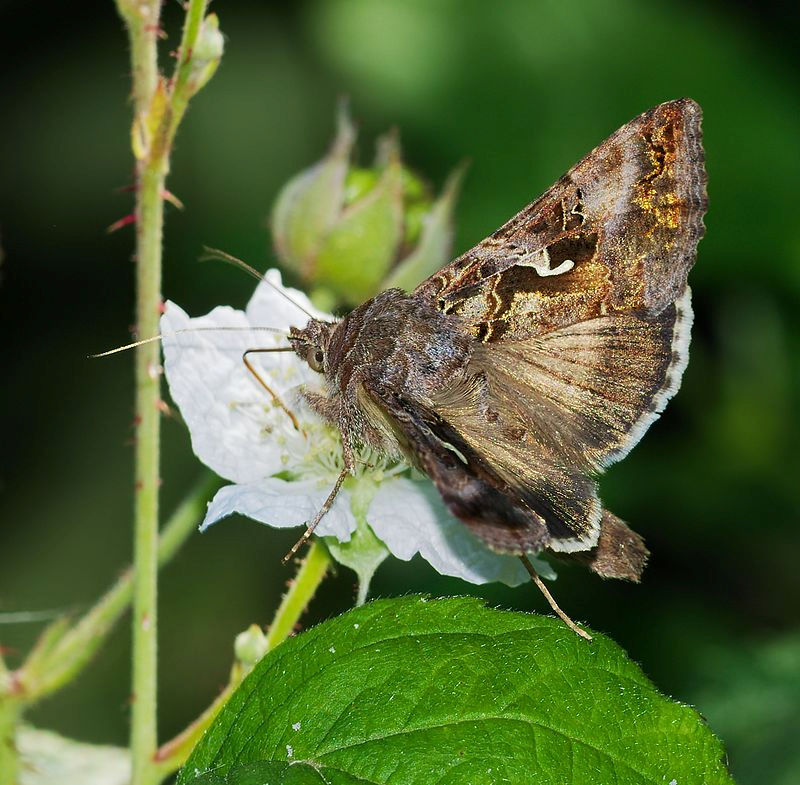
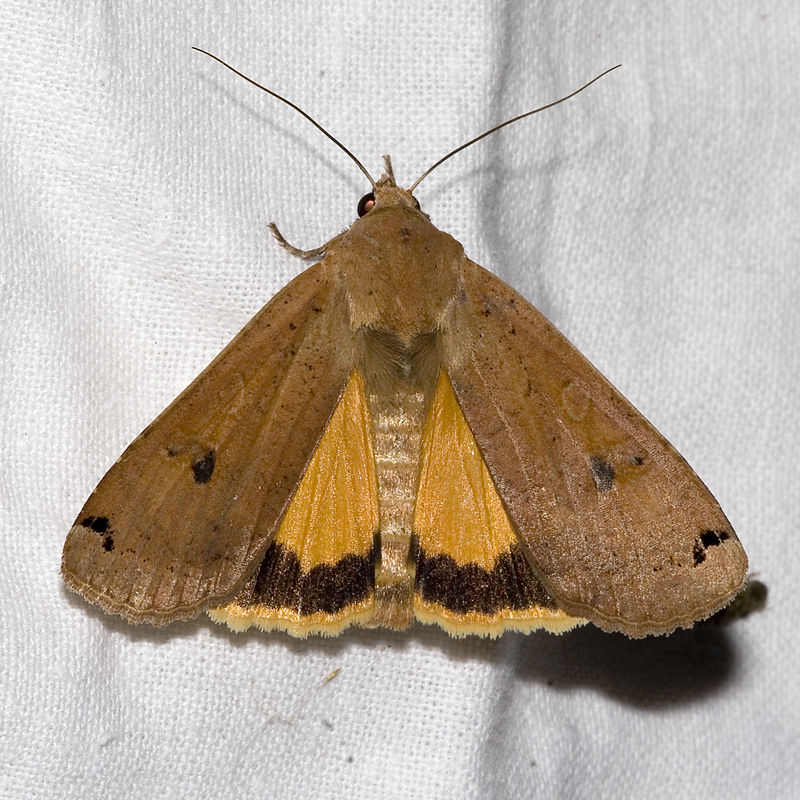
Left: silver Y Autographa gamma Right: large yellow underwing Noctua pronuba.
Burnet moths Family Zygaenidae
The burnet and foresters are a group of exotic-looking moths, with striking colours and often a metallic sheen on the wings. They are grassland species, and only one is likely occasionally to occur in gardens. This is the six-spot burnet moth Zygaena filipendulae , which is shiny black on body and forewing, with bright scarlet hindwings and 6 forewing spots. This is classic warning colouration and indeed these moths can release hydrocyanic acid "cyanide" which is highly toxic. This moth isn't often found in gardens, but can be encouraged (assuming you live near a colony) by growing birds-foot trefoil, which also is food for blue butterflies. The pupal cocoon of this species is very conspicuous, formed in full view high up on a plant stem.
.jpg)
.jpg)
Day-flying moths
The great majority of our moths fly in the night. If you have a moth trap you can capture them easily, but otherwise you are unlikely to see them except as caterpillars. There are however quite a number of species which are semi-active in the daytime, especially if disturbed, and a few which always fly in the daytime.
The definitive account of our day- flying moths is the new edition of the book by David Newland, Robert Still and Andy Swash listed below. 41 species listed in this book were recorded by Jennifer Owen in her garden - to which we can add a couple of others which may be seen occasionally. Moth families are illustrated in our introduction page.
Clearwing moths family Sesiidae
There are about 15 British and Irish species in this fascinating family, which specialises in rapid day-time flight, and mimicry of hornets, wasps and bees. They are not easy to find, but the males can be attracted to specific pheromone lures. We cover and illustrate these moths in our page on stem-boring moths.
Geometrid moths
There are about 60 day-flying geometrid moths in Britain and Ireland. Jennifer Owen recorded 8, of which the garden carpet Xanthorhoea fluctuata, the silver-ground carpet Xanthorhoea montanata and the common carpet Epirrhoe alternata were common. The blood-vein Timandra comae is an attractive garden species.
![Silver-Ground Carpet Xanthorhoe montanata Photo: by Ben Sale from UK - [1727] , CC BY 2.0, https://commons.wikimedia.org/w/index.php?curid=63701914](images/1280px-(1727)_Silver-Ground_Carpet_(Xanthorhoe_montanata)_(3119036200).jpg)

.jpg)
From left: silver-ground carpet Xanthorhoea montanata, common carpet Epirrhoe alternata, blood-vein Timandra comae
Humming-bird hawkmoth Macroglossum stellatarum Jennifer Owen considered this summer migrant moth scarce, but it appears increasingly often some years across most of (especially coastal) Britain and Ireland. They are very fast flyers, able to hover like a humming-bird to sip nectar with their long proboscis, and they make a clear humming noise in flight. They are known to breed here in good summers (larvae feeding on lady's bedstraw Galium verum) and some have over-wintered as adults. With climate change, this moth may become a resident species.


Humming-bird hawk moth
There are two other day flying hawkmoths in Britain, the bee hawks, but they are scarce and not found in gardens.
Erebid moths
The vapourer Orgyia antiqua and the muslin moth Diaphora mendica are day-flying erebids recorded by Jennifer Owen, but two other species seen in gardens are much more spectacular. The scarlet tiger moth Callimorpha dominula is found in gardens in western southern England and Wales and is as strongly day-flying as a butterfly. The cinnabar moth Tyria jacobaeae is a weaker flyer, but equally conspicuous. Its larvae feed on ragwort Senecio jacobaea. The ruby tiger Phragmatobia fuliginosa often flies in its spring brood, but is less likely to in the late summer generation.
.jpg)
Above Left: scarlet tiger moth Callimorpha dominula Right: cinnabar moth Tyria jacobaeae.
Below Left: muslin moth Diaphora mendica female and Centre: male. Right ruby tiger Phragmatobia fuliginosa



Noctuid moths
Most of these are night-flyers, but one species, the silver Y Autographa gamma is very common and often seen in the daytime, either as you disturb individuals as you walk through vegetation, or flitting from flower to flower. It is mainly a regular immigrant from the continent, arriving in early spring and then managing several generations before winter, which generally they do not survive. Another, in this case resident moth is the large yellow underwing Noctua pronuba. This is commonly disturbed from vegetation in mid summer, and flies away fast to hide, showing the bright yellow flash of the hind wing.


Left: silver Y Autographa gamma Right: large yellow underwing Noctua pronuba.
Burnet moths Family Zygaenidae
The burnet and foresters are a group of exotic-looking moths, with striking colours and often a metallic sheen on the wings. They are grassland species, and only one is likely occasionally to occur in gardens. This is the six-spot burnet moth Zygaena filipendulae , which is shiny black on body and forewing, with bright scarlet hindwings and 6 forewing spots. This is classic warning colouration and indeed these moths can release hydrocyanic acid "cyanide" which is highly toxic. This moth isn't often found in gardens, but can be encouraged (assuming you live near a colony) by growing birds-foot trefoil, which also is food for blue butterflies. The pupal cocoon of this species is very conspicuous, formed in full view high up on a plant stem.
.jpg)
.jpg)
Other sources of information
Websites
Books
Newland D.E, Still R. and Swash A. (2019) Britain’s Day-flying Moths: A Field Guide to the Day-flying Moths of Britain and Ireland. Princeton University Press
Field Studies Council (2006) ID Chart - Guide to the Day-flying Moths of Britain
Page drafted and edited by Steve Head
